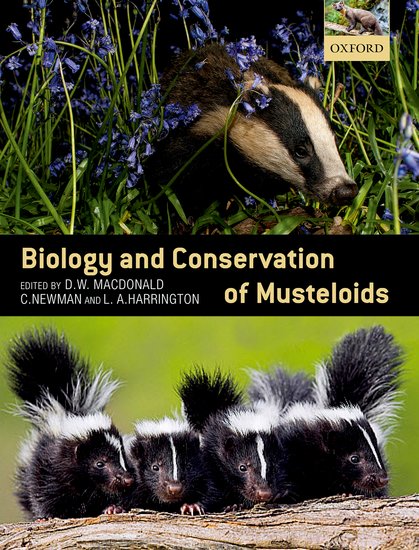News
David Macdonald celebrates two weasily WildCRU wonders to mark the publication of a landmark book and an entertaining film
Musteloids, despite their odorously ominous name, are a wonderfully diverse, and rivetingly interesting super-family of Carnivores. They include such carnivoran eccentrics as red pandas, coatis and skunks, but the huge majority of them, indeed 67 of the approximately (given taxonomic wrangling) 92 musteloid species, are mustelids, that is, members of the weasel family. As variations on an evolutionary theme, they are all long, thin and stinky – indeed their roots lie in the evolution of grasses that in turn led to the proliferation of burrowing rodents and, with nature’s abhorrence of a vacuum, opportunities for tunnel-running predators. Nowadays, many musteloids continue their trade as nemeses of rodents, but others – such as otters and mink – are variously aquatic, some, such as martens are wondrously arboreal, while the wolverine prowls the Arctic and the kinkajou sips nectar. Amidst this diversity is adaptation to blow the naturalistic mind, and it threads through their, ecology, behaviour, anatomy, and population biology, with implications for everything from wildlife diseases to conservation. All these details, and more, are the topics of the 720 pages and 30 chapters of the ‘Biology and Conservation of Musteloids’, Oxford University Press. This extraordinary tome represents the work of 69 world-class authors, and coordinating their genius, along with demonstrating that herding weasels is no easier than herding cats, consumed four years of fruitful energy by my WildCRU co-editors Chris Newman and Lauren Harrington.
To whet your appetite while awaiting delivery of your copy of the book, have a quick look – it takes only 4 minutes – at our video, also published this week, about the badgers of Wytham Woods. These badgers feature largely in the book, but while words (in this case circa 300,000 of them) are worth a lot, the aphorism tells us that a picture is worth a 1000 words, so look at the film to see for yourselves some of the eccentricities of the badgers, and those who study them.
You can watch the film at: https://youtu.be/NrQutaWARrw. It is part 14 of a study of Wytham Woods, known as The Laboratory with Leaves: http://www.ox.ac.uk/content/wytham-woods-laboratory-leaves.
Returning to the book, it explains how musteloids are the most diverse super-family among carnivores, ranging from little known, exotic, and highly-endangered species to the popular and familiar, and include a large number of introduced invasives. They feature terrestrial, fossorial, arboreal, and aquatic members, ranging from tenacious predators to frugivorous omnivores, span weights from a 100g weasel to 30kg giant otters, and express a range of social behaviours from the highly gregarious to the fiercely solitary.
The volume is designed to be both topical and enduring. It comprises 20 cutting-edge research case studies, authored by world leading experts covering a wide range of conservation ecology topics affecting this diverse superfamily, along with 9 major reviews synthesising current knowledge on evolution, adaptation, population dynamics, communication, sociology, conflicts with people, study techniques, disease and management challenges in applied conservation. We then conclude with an evaluation of threats and solutions most pertinent to promoting this group’s continued global success through the 21st Century.
For collectors, the ‘Biology and Conservation of Musteloids’ forms a trilogy with sister volumes on the ‘Biology and Conservation of Wild Canids’ and ‘Biology and Conservation of Wild Felids’; they are also available together as ‘Biology and Conservation of Wild Carnivores’, occupying almost an entire bookshelf, and offer incomparable insight into the biology and conservation of, arguably, the most, intriguing, beautiful and charismatic Order of mammals.
My sincere thanks to all of my colleagues contributing to this wonderful new book and I very much hope it informs and inspires a wide readership.






